From Artifacts to Interactivity: Optimizing Museum Outreach through Technology and Inclusivity
DOI:
https://doi.org/10.70088/9erm5774Keywords:
museum promotion, cultural heritage, audience engagement, digital technology, social inclusivityAbstract
With the development of society, people are paying more and more attention to cultural protection, and museums have become the core of protecting and sharing cultural heritage. Today's museums are not just exhibition halls. They are educational centers and social spaces that help cultivate a sense of history, cultural identity, and community cohesion. However, many traditional museum practices are difficult to attract modern audiences, especially young tourists who pursue immersive experiences. This study analyzed the influencing factors of well-organized and well-designed promotional activities in museums, with a focus on exploring how to strengthen the role of museums as educational, social, and cultural resources. By studying core principles such as structured planning, creativity, and feasibility, this article provides feasible suggestions for strengthening museum promotion strategies. With the integration of modern technology, enhanced interactivity, and widespread use of digital media and targeted activities, museums have the opportunity to expand their audience, cultivate sustained connections, and promote cultural diversity. The study ultimately emphasizes the value of strategic external connections and positions museums as active contributors to cultural dialogue. These perspectives aim to help museums adapt to technological advancements, change public expectations, and lay the foundation for further research on digital participation, visitor protection, and international cultural exchange.
Downloads
Published
Issue
Section
License
Copyright (c) 2024 Mian Wei (Author)

This work is licensed under a Creative Commons Attribution 4.0 International License.











